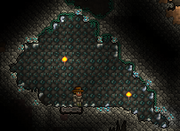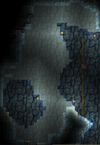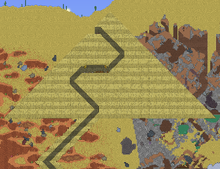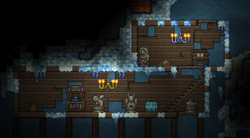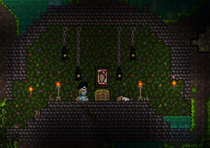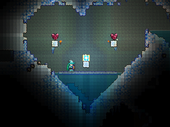Biomes (Biomes/it)
Per Ambientazioni riferisce a differenti tipi di aree che un mondo di Terraria può contenere. Essi possono contenere i loro caratteristici blocchi, oggetti collezionabili, sfondi, Muri, nemici, criceti, musica, pesci delle missioni del Angler, e tanti altri tratti.
L'ambientazione più comuni sono le Foreste, presenti in superficie. Andando più a sinistra o destra eventualmente porta a la Corruzione o Cremisi, Deserti, Neve, Giungla, il Dungeon, e alle due estemità del mondo, gli Oceani.
Gli ambienti "Sotterranei" iniziano allo strato della Caverna e includono il Funghi Sotterranei, la Giungla Sotterranea, Neve Sotterranea e il Deserto Sotterraneo.
Il mondo è anche diviso in Strati che descrivono le caratteristiche del mondo a seconda della profondità. Gli strati più alti e più profondi, Spazio in cima e L'Inferno in fondo, hanno ambienti simili per tutta la mappa orizzontalmente. Gli altri ambienti possono anche essere introdotti a questi strati (piazzando blocchi appropriati) per sovrapporli con questi in profondità.
Dopo aver sconfitto per la prima volta il Wall of Flesh nel Inferno, il mondo si converte in Hardmode, e nuovi punti di Corruzione o Cremisi si formano, cosi come un nuovo ambiente, come la Consacrazione, oltre che la variante sotteranea dei questi.
La Corruzione, Cremisi e Consacrazione sono tutti ambienti "contagiosi", in quanto si propagano ai blocchi adiacenti. Prima di Hardmode, la Corruzione/Cremisi si propaga con la loro erba, ma una volta che esso comincia, tutti e 3 ambienti si propagano direttamente per la maggior parte del Suolo, Liane, e Cespugli spinosi. Tutti e tre di questi possono essere rimossi da piccole sezioni della mappa con Thrown Powder/it, e creati similmente con Thrown Water/it. Il Clentaminatore può aggiungere o rimuovere qualsiasi ambiente per un area molto più vasta della mappa, usando Soluzioni come Munizioni.
Lo Spazio
Lo Spazio è uno strato che appare in cima al mondo: 700 piedi e oltre, per i mondi di Media grandezza. Il cielo è buio e le stelle sono visibili, anche quando il sole è ancora su, e la gravità bassa influisce i giocatori e nemici.
Nonostante ciò, i nemici comunque appaiono nello spazio. anche se in misura inferiore. Lo spazio ha uno sfondo e una musica esclusiva, e i suoi nemici distinti (Inizialmente solo Arpie, in Hardmode si aggiungono i Draghi).
Superficie/Sotterranei
Gli ambienti che appaiono al di sopra dello delle Caverne operano come ambienti superficiali, anche se possono estendersi sottoterra. La vera versione "Sotterranea", come la Neve Sotterranea, con caratteristiche tipiche dei Sotterranei, non iniziano finchè non si entra nello strato delle Caverne.
Foresta
Le Foreste sono l'ambiente in superficie più comune, ed è dove il giocatore di solito appare quando comincia un nuovo mondo. L'Erba verde cresce per il Terreno, che può crescere Funghi, Fiordigiorno e Alberi. Essi appaiono quando gli altri ambienti non possono apparire.
Neve
La Neve è un'ambiente invernale e fatto con blocchi di Neve e Ghiaccio. Occasionalmente il giocatore appare per la prima volta qui in un nuovo mondo. La neve cade costantemente, seppur questo è solo estetico. La Neve è sempre localizzato al lato opposto della Giungla e quindi nello stesso lato del Dungeon.
Almeno 300 blocchi di neve o ghiaccio sono necessari per creare questa ambientazione.
Deserto
I Deserti sono una grande distesa di Sabbia che richiede almeno 1000 sabbia o altri blocchi desertici per crearlo. Sono spesso trovate tra Foreste.
Corruzione e Cremisi
Un mondo viene sempre generato con Corruzione o Cremisi, ma mai entrambi. Entrambi sono ambienti pericolosi che offrono accesso a bottini, Materiali, e Boss importanti. Nella versione ![]() Desktop,
Desktop, ![]() Console, and
Console, and ![]() Mobile, il giocatore è capace di scegliere quale ambiente che il loro nuovo mondo genera, purchè hanno sconfitto il Muro di Carne in un mondo separato, ma che altrimenti ha un 50% di possibilità che uno o l'altro viene selezionato.
Mobile, il giocatore è capace di scegliere quale ambiente che il loro nuovo mondo genera, purchè hanno sconfitto il Muro di Carne in un mondo separato, ma che altrimenti ha un 50% di possibilità che uno o l'altro viene selezionato.
- La Corruzione segue un tema tenebroso e contiene voragini, Sfere d'ombra e Altare del Demone.
- La Cremisi segue un tema sanguinoso e contiene passaggi angolati, Cuore Cremisi e Altare Cremisi.
Giungla
La Giungla è un'ambientazione superficiale difficile composta da Erba di Giungla, Liane, Fango e Alberi di Mogano scuro. Il cielo ha una colorazione verde vibrante. L'Albero di Mogano scuro ricresce da sola, senza l'uso delle Ghiande. La Giungla sarà sempre localizzato nel lato opposto della Neve e Dungeon.
Dungeon
Il Dungeon è un Labirinto difficile che parte dalla superficie, quasi raggiungendo le profondità dell'Inferno. All'entrata si trova il Vecchio, e parlando con lui puoi sconfiggere Skeletron, che è richiesto per entrare. Se entri senza sconfiggere Skeletron, uno o più Guardiani del Dungeon appaiono e ti uccidono (se raggiungi la profondità -3). Il Bottino che trovi nel Dungeon sono rari, di valore e non possono essere trovati da nessuna parte. Il Dungeon è sempre al lato opposto della Giungla e quindi nello stesso lato della Neve.
Oceano
Ad ogni estremo di ogni mappa c'è un profondo corpo d'acqua, dove i nemici acquatici appaiono, e Casse d'Acqua contengono bottino collerato al Oceano.
Funghi
La versione superficiale del ambiente dei Funghi non occorre naturalmente, ma può essere coltivato dai giocatori, usando Semi di Fungo or il Clenataminatore con Soluzione Blu Scura nel Fango in superficie. A prescindere dall'orario esso appare sempre più cupo della notte.
Caverna
Lo strato delle Caverne rappresenta l'inizio degli ambienti Sotterranei, con caratteristiche separate dalle loro varianti superficiali.
Neve Sotterranea
Questo è la porzione della Neve nello strato delle Caverne. Molti ripiani e corpi d'acqua avranno uno strato di Ghiaccio sottile sopra, che se possono sopportare il peso del giocatore, is possono rompersi se atterri cadendo abbastanza rapidamente. Puoi evitare ciò con i Pattini da ghiaccio o Stivali lampo di gelo. Le Casse di ghiaccio contengono equipaggiamento a tema ghiacciato. Contiene nemici più pericolosi rispetto alla controparte superficiale.
Funghi Sotterranei
Questo ambiente contiene Funghi luminosi su fango, e se soffitto della caverna è abbastanza alto, i funghi giganti possono crescere. Ha uno sfondo unico. È l'unico posto dove puoi ottenere Vermi tartufo.
Giungla Sotterranea
La Giungla Sotterranea è un'ambiente difficile che si trova negli strati delle Caverne, sotto alla Giungla superficiale. Le sue dense catacombe contengono svariati pericoli e una densa vegetazione, cosi come bottino importante. In Hardmode, Clorofite può essere scavato qui. Ci sono 3 boss. Qui vigono gli Alveari, dove si trova l'Ape Regina. Dopo che i Boss Meccanici sono stati sconfitti, cominciano ad apparire Germogli di Plantera, permettendo ai giocatori di evocare Plantera, un boss importante. Il Tempo della Giungla si trova anche qui, dove Golem può essere evocato dopo aver sconfitto Plantera.
Deserto Sotterranea
Il Deserto Sotterraneo è un ambiente difficile localizzato nello strato delle Caverne sotto il Deserto. Esso è sempre a forma di una sfera e contiene vari tipi di Formicaleone cosi come nemici egiziani in Hardmode.
Underworld
The Underworld is a difficult area located along the entire bottom of the world. Lava pools cover much of its terrain and dangerous enemies spawn often. Hellstone can be mined here, Ruined Houses offer valuable loot (some within their Shadow Chests), and unique furniture, and the Wall of Flesh boss can be summoned here in order to activate Hardmode. In hardmode, you can find the Tortured Soul here, which you can convert to the Tax Collector NPC using Purification Powder.
Hardmode
Hardmode biomes spawn or convert as a result of the game transitioning to Hardmode.
The Hallow
The Hallow is the "anti-corruption" biome, which is automatically created once the player activates Hardmode by defeating the Wall of Flesh. The biome has pastel-colored imagery but is nevertheless highly difficult.
Underground Hallow
The Underground Hallow is located beneath surface Hallow, starting at the Cavern layer. It has a different soundtrack from the overworld Hallow, and contains even more difficult enemies as well as valuable items, like Soul of Light and Crystal Shard.
Underground Corruption
The Underground Corruption is created in the Cavern layer upon defeating the Wall of Flesh. It shares the same feel as the overworld Corruption, but has different enemies, a different soundtrack (a mix of the regular Underground and Corruption soundtrack), and it's the only place to find Souls of Night and Cursed Flames. All enemies from the overworld version are present, as well as World Feeders, Clingers, and Cursed Hammers.
Underground Crimson
The alternative to the Underground Corruption, which functions and is spawned in mostly the same way. The Underground Crimson, like the Corruption variety, will have enemies occasionally drop Souls of Night. This is the only place where enemies drop Ichor.
Corrupted/Crimson Deserts & Hallowed Deserts
When the world enters Hardmode, several Deserts of the world will become either corrupted, crimsoned, or hallowed. These have their own backgrounds, and spawn unique versions of the Mummy with unique drops. Sand is replaced by Ebonsand, Crimsand, or Pearlsand. It is possible for a world to be generated with a Corrupt or Crimson Desert.
Mini Biomes
Biomes in this category tend to be small in number and size. They have unique characteristics and monster spawns.
Meteorite
Whenever a Shadow Orb or a Crimson Heart is destroyed, there is a chance that within the next day the game will spawn a meteor and display the message "A meteorite has landed!". The meteor will crash into land and turn a large portion of the surrounding tiles into Meteorite. Meteorite will defect the player with the Burning debuff if they do not have an accessory that nullifies fire's effects, and/or an Obsidian Skin Potion. Meteorite requires a Tungsten Pickaxe, Gold Pickaxe, or better, in order to mine the meteorite. Meteor Heads and Lava Bats are the only enemies that spawn instead of the other natives.
Spider Nest
Spider Nests are rare mini-biomes that can be located underground, noted by the black background wall and the numerous webs filling the area. This biome will spawn Wall Creepers before Hardmode and Black Recluses during Hardmode. The Cobwebs filling this area rapidly grow back, which is a unique feature of the biome. Spider Nests are the only location where one can find Web Covered Chests and all unique treasures discovered therein. The Stylist NPC is found in this biome.
Bee Hive
The Bee Hive occurs in the Underground Jungle. Bee Hives are made from Hive blocks and contain Honey and often a Larva. If you destroy the larva, it will summon the Queen Bee boss. When you break a Hive block, a bee and/or honey may come out. There can occasionally be two or three hives next to each other.
Jungle Temple
A large, near impenetrable, structure that spawns deep in the Underground Jungle. It is filled with powerful enemies and is only accessible after defeating Plantera and using a Temple Key to open the door. In the largest chamber, you can spawn Golem.
Marble Caves (Desktop, Console and Mobile versions)
An Underground cave area that is horizontal in shape and made completely out of Marble. It is generally themed around Ancient Greece. Marble Caves contain enemies such as Hoplites and Medusa.
Granite Caves (Desktop, Console and Mobile versions)
An Underground cave area made completely of Granite, usually quite spacious with interspersed ledges and platforms. Granite Caves contain enemies such as Granite Elementals and Granite Golems.
Micro Biomes
Gemstone Cave
A Gemstone Cave is filled with concentrated gem deposits of one or more varieties and features a unique background (a gemstone wall) that is speckled with gems of the same color found in the Gemstone Cave.
Moss Chamber
A micro biome found in the Underground and Cavern layers that contains one color of Moss with a matching back wall.
Campsite
A micro biome found in the Underground and Cavern layers usually containing a Campfire, Silver Coin Pile, and a background object of skeletal remains. The campsite is 12 - 20 blocks wide, and not quite as tall.
Thin Ice Patch
A micro biome found in the Ice biome that is made entirely of Thin Ice and the occasional ore vein.
Treasure Rooms
Treasure rooms are spawned with world creation and appear as if they were man-made structures. They generally contain loot and furniture.
Floating Islands
Floating Islands are independent masses of land in the sky. Once located, and when the player obtains the tools to reach them, they have access to their unique furniture and some powerful loot. Harpies (Arch Wyvern(Old-gen console and 3DS versions) and Wyvern in Hardmode) attack at their height.
Living Tree
Living Trees are huge, thick trees that can be generated. Cutting the tree yields regular Wood. Some of those trees can be hollow and lead deep underground. There may be rooms containing Living Wood Chests with related loot inside, as well as Living Wood Doors, Living Wood Chairs, Living Wood Tables, Living Loom and other Living Wood furniture. It is not guaranteed that one will spawn in every world.
Pyramid
Pyramids are sometimes generated in the Desert at world creation. They are made of Sandstone Brick and contain a narrow passage. The treasure room is filled with coins, vases and a gold chest that can contain unique loot, also in the mobile version there is usually another secret room containing more vases, money, and chest. There is also a passage to a cave at the bottom. It is not guaranteed that one will spawn in every world.
Underground Cabin
Underground cabins are typically wooden buildings full of dusty, broken furniture as well as chests, vases, and occasionally usable furniture and decorations. They are found in the underground in the cavern, glowing mushroom, jungle, desert, and snow biomes. As of 1.3.0.1, underground cabins now spawn with wood and walls that are unique to their biome.
Jungle Shrine
Jungle Shrines are small brick buildings and typically contain only a single chest and a light source. They are found in the Underground Jungle and several can appear in one biome.
Enchanted Sword Shrine(Desktop, Console and Mobile versions)
Houses an Enchanted Sword, an Arkhalis or a fake sword. Every shrine will contain one breakable background sword sprite, which has a 2/3 chance of being a fake sword and a 1/3 chance of being a real sword, which has a 1/10 chance of dropping the Arkhalis, instead of the Enchanted Sword, when destroyed.
Ruined House
Ruined houses are generated at World creation in The Underworld in the middle 50% of the Underworld. They are towers with multiple levels, constructed with missing parts for a "ruined" look, from Obsidian Brick or Hellstone Brick. They are sometimes partially submerged in lava and often contain deposits of hellstone just outside their walls.
Jungle Sanctum
A Jungle Sanctum is a removed exclusive structure that occasionally appears in Jungles. Jungle Sanctums are a larger version of Jungle Shrines and contain Coin Stashes, along with an Ivy Chest that contains several jungle-themed items.
Heart Shrine
Exclusive to the Mobile version before it was removed, Heart Shrines are heart-shaped caves sometimes found in Snow biomes. They hold two Crystal Hearts and a chest that may contain "heart"-items. They can contain Heart Lanterns, Heart Statues, Heart Potions, among other items.
Hybrid Biomes
While many of the basic biomes appear at world generation or triggered by events, it is possible for hybridized biomes to be synthesized by player action or, in Hardmode, by world mechanics.
Hybrid Biomes
Hybrid biomes are those created by the requirements being met for multiple biomes in a certain space. The simplest examples are Hallowed, Crimson, or Corrupt Deserts; however, not only Deserts can be hybridized. Floating Islands can be Corrupted/Crimsoned or Hallowed upon entry of Hardmode, and such high-layered biomes are even required by some Angler quests. Player action can similarly introduce Corruption, Crimson, Hallow, Desert, Jungle, Mushroom, Meteorite, or Snow biomes to any location from Underworld to Sky and likely even Space. This can lead to, for example in an Underworld Crimson, Underworld and Crimson enemies both spawning in the applicable areas.
Biome Existence Requirements
The area used for counting required blocks for the existence of biomes at a location, appears to be 50 tiles to each side and approximately 42 below and 44 above. Note that Compatible Biomes lists the biomes which can co-exist in the same general location, and has nothing to do with spreading mechanics.
| Name | Block Requirements | Location | Compatible Biomes |
|---|---|---|---|
| Forest | N/A | Above the Underworld | Sky, Surface, Underground, Cavern, Ocean |
| Corruption | At least 200 |
Any | Not Forest, Meteorite, or Hallow |
| Crimson | At least 200 |
Any | Not Forest, Meteorite, or Hallow |
| Mushroom | At least 100 |
Any | Not Forest or Meteorite |
| Jungle | At least 80 |
Any | Not Forest or Meteorite |
| Hallow | At least 100 |
Any | Not Forest, Meteorite, Corruption, or Crimson |
| Desert | At least 1,000 |
Any | Not Forest or Meteorite |
| Corrupt Desert |
At least 1,000 |
Any | Not Forest, Meteorite, or Hallow |
| Crimson Desert |
At least 1,000 |
Any | Not Forest, Meteorite, or Hallow |
| Hallow Desert |
At least 1,000 |
Any | Not Forest, Meteorite, Corruption, or Crimson |
| Ocean | At least 1,000 block spaces of |
Outer lateral edges of the world, above Cavern layer | Not Meteorite, Corrupt Desert, Crimson Desert, or Hallowed Desert |
| Snow | At least 300 |
Any | Not Meteorite or Desert |
| Meteorite | At least 50 |
Any | None |
| Dungeon | At least 250 |
Below -4 feet | None |
- ↑ Note that the requirement for naturally-placed Walls makes a synthetic Dungeon biome nearly impossible and, if accomplished, it would be unable to spawn Hardmode Dungeon enemies or Cursed Skulls (as they require naturally-placed Dungeon Brick Walls), though it may be useful for creating a lake for farming Dungeon Crates. It appears that the only option for expanding the space in which Hardmode Dungeon enemies can spawn is by mining blocks already inside the area in which the Dungeon originally generated, without damaging any naturally-placed Walls they are covering.
Notes
- For Hallowed and Crimson/Corruption biome detection: There is a Hallowed value, a Crimson value, and a Corruption value. Each Hallowed block adds 1 to the Hallowed value and subtracts 1 from both the Crimson and Corruption values. Each Crimson block adds 1 to the Crimson value and subtracts 1 from the Hallowed value. Each Corruption block adds 1 to the Corruption value and subtracts 1 from the Hallowed value. This can be proven by placing 100 Hallowed blocks in an otherwise completely neutral area, observing that the area will change to Hallowed on placement of the 100th block, then that it will return to neutral on placement of a Crimson or Corruption block, then back to Hallowed on placement of an additional Hallowed block, ad infinitum.
- For Snow biome detection: the background of a snow biome will not appear until 301 Snow biome blocks are present (not at 300, where the biome changes functionally).
- For Dungeon biome detection: the game checks the number of Dungeon blocks (=>250), and checks only the single background wall the player is standing in front of. This wall must be naturally placed, from the original world creation.
- Inactive blocks (Actuated blocks) will count towards the formation of a biome.

























